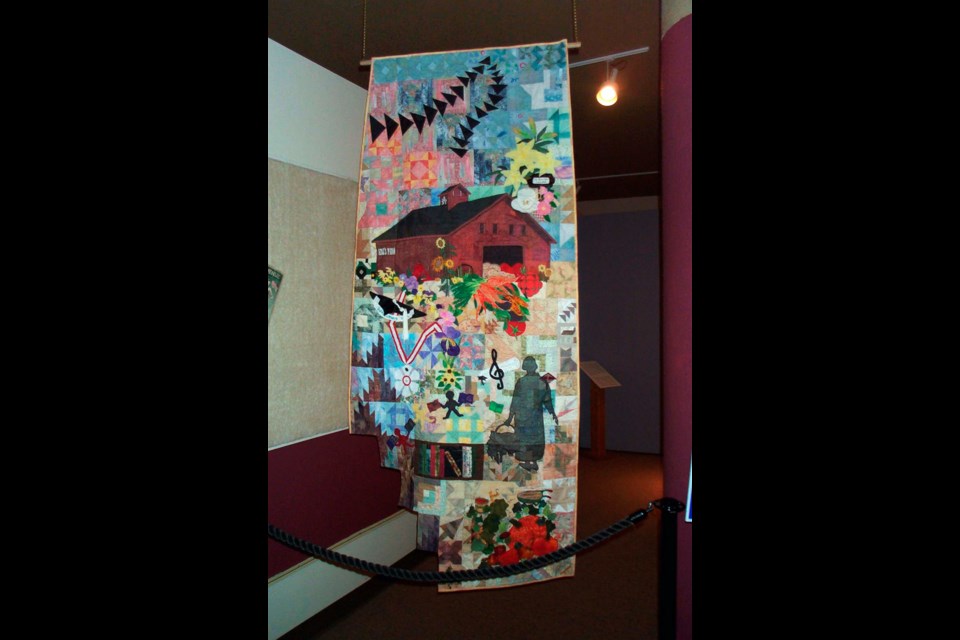DETAILS
Alberta Quiltmakers and their Quilts
by Lucie Heins
176 pages
$59.95
Friends of Royal Alberta Museum Society
Available for purchase online via frams.ca/quilting-book or at the Royal Alberta Museum
A quilt is not a mere blanket. It is an heirloom and shared heritage all in one. As such, blankets place themselves among some of the higher forms of art for their decorative flair, functionality, and for how they preserve moments in human history by place and by culture.
Just ask Lucie Heins, assistant curator for the Daily Life and Leisure program at the Royal Alberta Museum. She recently published Alberta Quiltmakers and Their Quilts after an exhaustive near-decade of research and documentation.
The book is the result of all that hard work. It’s as loving and detailed an overview of the practice and the product as a book can get. Just ask its author. To her and to many others, quilts are important historical documents, as the book reveals.
“I spent 10 years researching Alberta quilt makers. I started off documenting actually 21st-century quilt makers because I was a little bit daunted by the task of trying to capture the early history of quilt makers. Why not capture 21st-century quiltmakers while they're around to tell me what they're doing?” she began.
“Of course, quilting has changed a lot during the 21st century.”
To inform this book, she traveled across the province to visit and gain the collaboration of 38 community museums from Cardston to Fort Vermilion, hosting public quilt documentation events to foster interest and participation from the public.
“One of the things I discovered was the quilts that were in many of the museums often don't have a lot of history. They were often given to the museum because the family didn't know what to do with [them]. They knew it was in the family, but they didn't have the story. The real histories and the real stories were of quilts that still belonged within families.”
The histories she compiled along the way are beautiful and telling glimpses into people’s lives from decades past. The book offers stories such as that of Katherine Hittinger, the Iowa-born woman who suffered from crippling arthritis throughout her life. Later settling on four quarters of land (previously owned by Bishop Grandin) in Morinville, she quilted bedcovers for her eight children despite the pain, teaching piano and maintaining her family’s 600-egg incubator in the meantime. She took a job teaching English at the Morinville School, the school’s first permanent position, making her the first teacher with a teacher’s certificate.
The book highlights quilts from the late 19th century to the 21st century, with a focus on those made during the 20th century. It offers 12 in-depth stories about individual quilt makers interspersed in the chapters that detail quilters’ ingenuity and the impact of quilting on communities.
She explained that the quilts to be documented had to be made before 1970 because there was a resurgence in quilting after the 1970s. The pre-1970 time period was a fertile one for quilters in the province, primarily because this is a wintry northern province.
"Of course, Alberta quilt makers quilted mostly by necessity. They needed bedding for beds; they needed to keep their family warm at night during Alberta's cold winters. Of course, certainly in the early first half of the 20th century, not many houses had central heating or had poor insulation. The houses were much colder than they are today. Quilting was a necessity."
During her cross-province research, Heins did make a stop at the Musée Héritage Museum for another documentation spree.
With six quilts in the museum's collection (one of which is a pillow covering), curator Joanne White explained the benefit of that documentation.
"It was very, very helpful to have that documentation and have someone who's an expert look at them. Like any of the parts of our collections, it's so nice to have someone with the specific knowledge come in and give you more info that you can connect to the objects," she said.
"We have a couple of pieces by Justine Bellerose that go back a century, most likely the 1920s or 1930s. We have a couple that came from Margaret Plain’s family.
The museum also commissioned the St. Albert Quilters’ Guild in 2000 to make a quilt for Connected Voices, an exhibit celebrating the women of St. Albert. The result of that was the Lois Hole Quilt, which contains many symbols of the life and accomplishments of the late Hon. Lois Hole.
That quilt didn't make it into the book but what did is featured in the chapter on Community Quilts. Called The Class of 1963 Quilt, it was made in 2013 by the Quilters' Guild to celebrate the 50th anniversary of the University of Alberta graduating nursing class. The medallion piece of the quilt was actually a banner that was made for the class's very first five-year reunion in 1968. The quilt itself is made with the friendship star block pattern used on both the front and back to represent each student.
Heins explained how this one quilt exemplifies the historical importance of quilting.
"Their names are also printed on the top and bottom of the central medallion banner, and the fabric that was used was from 15-year-old nursing uniforms and aprons. Only the thread and the batting was purchased new. This quilt has some blue fabric, which would have been from the first-year student uniforms and then the pink fabric was from the second- and third-year uniforms. The white would have come from the aprons. It's really a stunning quilt. What this quilt does is it documents an event at a certain time and place. They become a document of what happened at this time."




